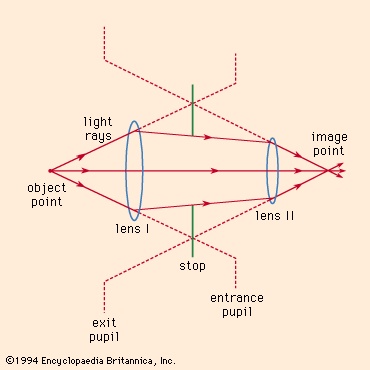pupil
eye
in the anatomy of the eye (eye, human), the opening within the iris through which light passes before reaching the lens and being focused onto the retina. The size of the opening is governed by the muscles (muscle) of the iris, which rapidly constrict the pupil when exposed to bright light and expand (dilate) the pupil in dim light. Parasympathetic nerve fibres from the third (oculomotor) cranial nerve innervate the muscle that causes constriction of the pupil, whereas sympathetic nerve fibres control dilation. The pupillary aperture also narrows when focusing on close objects and dilates for more distant viewing. At its maximum contraction, the adult pupil may be less than 1 mm (0.04 inch) in diameter, and it may increase up to 10 times to its maximum diameter. The size of the human pupil may also vary as a result of age, disease, trauma, or other abnormalities within the visual system, including dysfunction of the pathways controlling pupillary movement. Thus, careful evaluation of the pupils is an important part of both eye and neurologic exams.
optics
 in optical (optics) systems, the virtual image of an aperture associated with mirrors, prisms, and lenses and their combinations. The Figure-->
in optical (optics) systems, the virtual image of an aperture associated with mirrors, prisms, and lenses and their combinations. The Figure--> shows the case of an optical system composed of two lenses with a stop between them. The virtual image of the aperture for lens I (as seen from the object point) is called the entrance pupil. The amount of light leaving the object and traversing the system is limited, in effect, by the entrance pupil, just as it is actually by the stop aperture. The image of the aperture for lens II is the exit pupil. In general, an optical system has one effective aperture, and the entrance pupil is formed by all lenses preceding the stop, whereas the exit pupil is formed by all lenses following it.
shows the case of an optical system composed of two lenses with a stop between them. The virtual image of the aperture for lens I (as seen from the object point) is called the entrance pupil. The amount of light leaving the object and traversing the system is limited, in effect, by the entrance pupil, just as it is actually by the stop aperture. The image of the aperture for lens II is the exit pupil. In general, an optical system has one effective aperture, and the entrance pupil is formed by all lenses preceding the stop, whereas the exit pupil is formed by all lenses following it.In visual instruments, the exit pupil falls at the eye position. In the microscope and telescope the objective acts as the aperture, its image is the exit pupil, and all light reaching the objective passes through the exit pupil. Thus, it is important for the exit pupil to be no larger than the pupillary diameter of the eye to take advantage of the light-gathering power of the instrument.
- flag of Malaysia
- flag of Mali
- flag of Malta
- flag of Manitoba
- flag of Maryland
- flag of Massachusetts
- flag of Mauritania
- flag of Mauritius
- flag of Mexico
- flag of Michigan
- flag of Micronesia
- flag of Minnesota
- flag of Mississippi
- flag of Missouri
- flag of Moldova
- flag of Monaco
- flag of Mongolia
- flag of Montana
- flag of Montenegro
- flag of Morocco
- flag of Mozambique
- flag of Myanmar
- flag of Namibia
- flag of Nauru
- flag of Nebraska